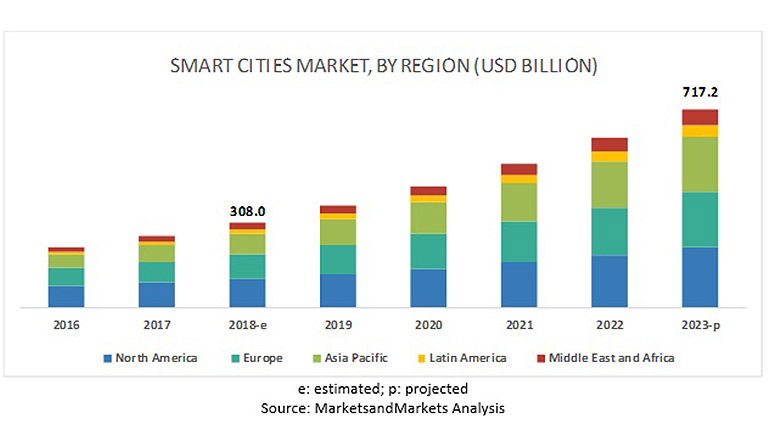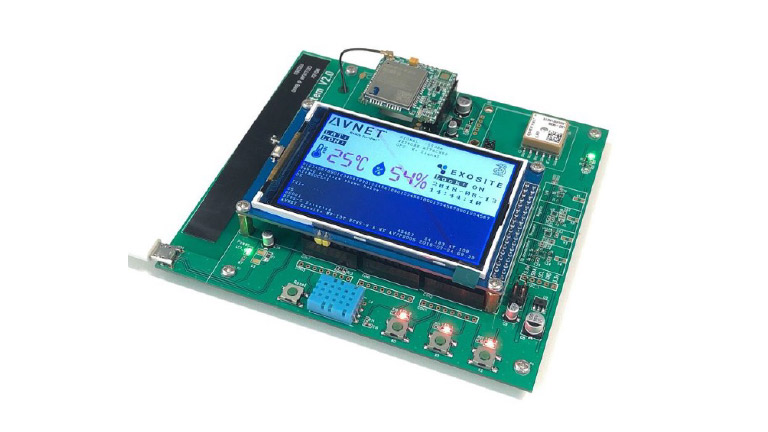A decade of smart cities: What has changed and what has remained unchanged...

In the latest global smart city development report published by MarketsandMarkets, the global market size for smart cities is expected to grow from US$308 billion in 2018 to US$717.2 billion by 2023, at a compound annual growth rate of 18.4%. Since its publication, the report has been widely cited by for its comprehensive analysis of smart city trends .

Figure 1. Global smart city market size (Image source: MarketsandMarkets)
The concept of smart cities can probably be traced back to 2008 when IBM issued a themed report titled “A Smarter Planet: The Next Leadership Agenda”, introducing the idea of “smart cities” and the revolutionary impact that next-generation information technology applications would have on urban life. The unveiling of this concept was akin to throwing a stone into a pond, generating immediate ripples. Over the next few years, the ripples not only didn’t subside, but intensified into stronger waves driving a surge of high-tech development.
Today, when we look back on the history of smart city development, we will find a continuous shift in the interpretation of smart cities. One of the main factors propelling this ongoing change is the transformation of the technology environment in which we live.
For instance, when IBM first introduced the concept of “smart cities,” cloud computing was just budding, Internet of Things (IoT) was a new term and notion, and artificial intelligence (AI) had not even left the research lab. By now, these three technologies have become keystones for building smart cities, changing how people understand the forms and functions of future cities.
Let’s first look at artificial intelligence, which has only been on the rise for the past two or three years but is already the hottest trending topic in every field, including smart cities. The core value of artificial intelligence is that machines are given the ability to learn by themselves. They do not need to follow specific programs, but make correct decisions and take action based on data. When this kind of “intelligence” becomes prevalent in devices throughout the urban landscape, the so-called smart city will enter into a whole new realm.
Take security monitoring, one of the main features of building smart cities, for example. Artificial intelligence allows surveillance cameras to incorporate identification, analysis and even predictive functions on top of simple recording and data storage. Not only does the camera “see” clearly and distinctively, it now “knows” what it’s viewing. For example, the Shenzhen police authorities deployed facial recognition technology to accurately identify traffic offenders, and there will be more and more similar applications in the future.
Next we’ll look at cloud computing, which could be said to have progressed alongside the development of smart cities. Since cloud computing gathers scattered computing resources and achieves flexible integrated assigning, the cost advantages are clearly evident, enabling it to become the current best choice for constructing IT systems. Any smart city project will have a robust cloud computing platform providing it with full back-end support.
Today, however, the development of conventional cloud computing has also reached a revolutionary crossroads: integrated computing faces various challenges such as transmission bandwidth, timeliness, security and energy consumption, necessitating the generation of a new computing topological structure with “integrated cloud computing + distributed edge computing.” More and more embedded artificial intelligence (inference functions) will be incorporated into network edge devices, rendering a large amount of edge devices “intelligent.” At this stage, the “omni-intelligence” experience in smart cities shall then become complete.
Finally, let’s look at the Internet of Things. The primary function of IoT is that it enables us to build an efficient and reliable wireless connection between the cloud and network edge devices, ensuring data transmission and interaction. At the beginning of smart city development, there were only a few wireless technologies to choose from as many were still local network technologies in a strict sense, making city-scale coverage clearly infeasible.
In recent years, the emergence of low-power wide-area network (LPWAN) technology has made possible wireless connections over several kilometers or even farther. In the very near future, 5G connection will further bring about varied wireless connection support to smart cities. Regardless of whether enhanced Mobile Broadband (eMBB), ultra-reliable, low-latency communication (URLLC) or massive machine type communications (mMTC) are called for, 5G will be the answer to them all. For this reason, smart cities in the era of 5G are bound to be even more exciting.

Figure 2. The NB-IoT Gen2 beginner’s kit by Avnet helps designers utilize NB-IoT network develop high-speed data networks for connecting IoT devices with ease and convenience
Regardless of how technological changes have affected people’s ideas and understandings of smart cities, some general views on smart city development trends have not changed over the years.
First of all, the intellectualization of cities is a shared “pain point” that will only become more “painful” over time. The development of human civilization can be roughly exemplified by the history of urbanization. Data shows that by 2030, there will be 5.1 billion people around the world living in cities, with medium or larger cities home to 55% of the world’s total population. While cities supply people with more developmental opportunities and benefits, increasingly serious “urban diseases” are unceasingly eroding city dwellers’ sense of fulfillment. “Intellectualizing” the city through technology to manage the city with better precision and efficiency is definitely the ultimate solution for solving this dilemma.
What’s more, smart cities are becoming a new force driving economic growth. As infrastructure construction, represented by reinforced concrete buildings, slows in growth, smart cities have undoubtedly become an intriguing new area of investment, which is why many countries and regions have incorporated smart cities into their development strategy plans—IDC even predicts that global smart city investment will reach US$158 billion by 2022. Smart city construction is especially hot in China. Till 2018, the Chinese government has approved over 290 smart city pilot projects, and it is estimated that China’s smart city market size will exceed RMB 650 billion in 2018.
Thus, as we review the past decade of smart city development, what has remained unchanged is the market base and the constantly upgrading technological environment that work together to create the foundations of smart cities. With these foundations firmly in place, the next decade of smart cities is worth looking forward to.

